Timeline of ichthyosaur research
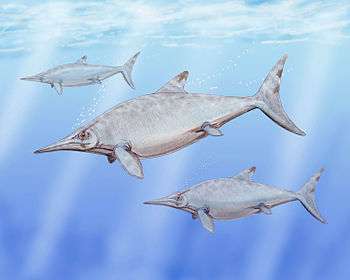
This timeline of ichthyosaur research is a chronological listing of events in the history of paleontology focused on the ichthyosaurs, a group of secondarily aquatic marine reptiles whose body plan is convergent with the body plans of dolphins, sharks, and swordfish. Scientists have documented ichthyosaur fossils at least as far back as the late 17th century. At that time, a scholar named Edward Lhwyd published a book on British fossils that misattributed some ichthyosaur vertebrae to actual fishes;[1] their true nature was not recognized until the 19th century. In 1811, a boy named Joseph Anning discovered the first ichthyosaur fossils that would come to be scientifically recognized as such.[2] His sister Mary would later find the rest of its skeleton and would go on to become a respected fossil collector in her own right.[3]
Early researchers recognized ichthyosaurs as marine reptiles, but major aspects of their anatomy and behavior needed to be resolved. They were frequently portrayed as leaving the water to bask on rocks and with straight tails.[4] Although a bend in ichthyosaurs' tail vertebrae was seen from the earliest specimens, scholars assumed the bend reflected damage incurred to the animal's carcass after death. This bend was so common, however, that scholars eventually realized that it was natural and supported a shark-like tail fin.[5] Scientists came to realize that ichthyosaurs were too adapted to leave the water even to lay eggs. Evidence for live birth in ichthyosaurs dates back as far as 1846, when Chaning Pierce reported an apparent fossil Ichthyosaurus embryo to Sir Richard Owen.[6]
Ichthyosaur discoveries continued to be made into the 20th century. In 1928, Simeon Muller discovered the remains of 40 gigantic ichthyosaurs in Nevada. However, these remains would not be excavated until Charles Camp and Samuel Welles of Berkeley led an expedition for the purpose in the mid 1950s.[7] These fossils would take more than a decade to excavate, and the results of Camp's examination of the bones would not be published until a year after his 1975 death. These giant ichthyosaurs were named Shonisaurus popularis and their final resting place is now known as Berlin-Ichthyosaur state park.[8]
Other notable late 20th century advances in ichthyosaur research include the recognition of a new genus of ichthyosaur called Eurhinosaurus longirostris that had been misclassified as a species of Ichthyosaurus since 1854.[9] In 1986 Christopher McGowan would describe another, similar animal serendipitously discovered in England as Excalibosaurus, after King Arthur's mythical sword.[9] The late 1990s and early 21st century would see scholarly debate regarding the cause of the ichthyosaurs' extinction, especially regarding the potential role played by competition with the mosasaurs which had evolved around the time.[10]
17th century
- Edward Lhwyd published a book called Lithophylacii Britannici Ichonographia about British fossils housed in Oxford's Ashmolean Museum. The book contained illustrations of unrecognized ichthyosaur vertebrae misidentified as belonging to fishes. 120 copies of the book were produced.[1]
19th century
1810s


1811
- Joseph Anning discovered the first scientifically recognized ichthyosaur remains.[2]
- Mary Anning found the rest of the original ichthyosaur skeleton discovered by her brother Joseph.[2]
1814
- An anatomist with the Royal College of Surgeons named Sir Everard Home described the ichthyosaur discovered by the Annings. He thought it formed a "link between fishes and crocodiles".[2]
1819
- Everard Home changed his mind about the relationships of Ichthyosaurus. Instead of linking fishes with crocodiles, he concluded that it linked salamanders and lizards.[2] He tried to rename it Proteosaurus after the salamander genus Proteus, but his original name had priority and is still considered official.[11]
1820s

1823
- Mary Anning or a member of her family discovered a complete Ichthyosaurus skeleton in Lyme Regis. The find aroused widespread curiosity about ancient life throughout Britain.[2]
- The Reverend George Young discovered an ichthyosaur fossil in Whitby, Yorkshire. He also described the specimen, noting that it shared traits with crocodiles, fishes, and dolphins. Young speculated that ichthyosaurs might still be discovered alive as more of the world's seas and oceans are explored.[12]
1830s

- Thomas W. Hawkins published a book titled Memoirs of Ichthyosauri and Plesiosauri. He sold it in subscription format for L2.10, an exorbitantly high price for the period.[13] The book included illustrations by landscape painter John Samuelson Templeton, although many of these inaccurately portray ichthyosaurs with straight tails and leaving the water to bask on rocks.[4]
- Henry de la Beche illustrated a work titled "Duria Antiquior", meaning "Ancient Dorset" for fossil hunter Mary Anning. This work, which prominently features plesiosaurs, has been regarded as the first attempt to accurately reconstruct the Mesozoic world through an artistic medium.[14]
1840s
- Chaning Pearce discovered that a specimen of Ichthyosaurus communis contained the skeleton of another, tiny I. communis partially protruding from the larger individual's pelvis. After discussing the fossil with Sir Richard Owen, Pearce concluded that the specimen was a female killed and preserved in the act of giving birth.[6]
1850s

- Gideon Mantell described the new species Ichthyosaurus longirostris based on fossil found in Whitby, Yorkshire. Its upper jaw was so much longer than its lower jaw that it resembled a swordfish.[9]
1853
- Henry Coles reported that ichthyosaurs were covered by scales resembling tiny hairs or spines. However, these supposed scales were actually hooklets from the tentacles of the prehistoric cephalopods the ichthyosaur had eaten.[15]
- Sir Richard Owen inaccurately reconstructed Ichthyosaurus as straight-tailed and able to bask on rocks for an outdoor exhibit at Sydenham.[5]
1860s
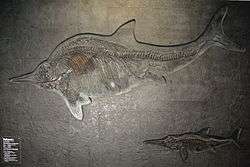
- Sir Richard Owen tried to rename the Ichthyosauria the Ichthyopterygia.[16]
- The first ichthyosaur fossils known from Australia were discovered in Queensland and named Ichthyosaurus australis.[17]
- Oskar Fraas of Stuttgart's Museum of Natural History documented the bustling ichthyosaur excavations at Holzmaden.[18]
1880s

- Harry Govier Seeley published an argument in favor of live birth in ichthyosaurs. Seeley noted that many ichthyosaur specimens from Britain and Germany contained miniature ichthyosaur skeletons inside them. While some researchers interpreted these remains as fossil stomach contents, Seeley observed that the smaller skeletons tend to be located too near the rear of the animal to be stomach contents. Instead, he interpreted the small skeletons as fetuses and the larger ones as pregnant females.[19]
- Georg Baur published a paper speculating on the origins of ichthyosaurs.[20] He concluded that ichthyosaurs were descended from relatives of the Sphenodontidae, the family that includes the modern tuatara.[21] He reclassified the species Ichthyosaurus cornalianus and I. atavus into a new genus, Mixosaurus. He also erected a new family for this genus, the Mixosauridae.[22]
20th century
1900s
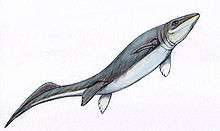
- J. C. Merriam named the new species Shastasaurus alexandrae after Annie Alexander, the wealthy fossil enthusiast who financed much of his research and founded the Museum of Paleontology at Berkeley.[23]
- J. C. Merriam described the new genus Toretocnemus from Late Triassic rocks in California.[24]
- J. C. Merriam discovered the unusual remains of an animal with short jaws and button-shaped teeth in Nevada. He thought it was the first member of a new group of reptiles related to placodonts or rhynchosaurs but it would actually come to be recognized as ichthyosaurian and described as the genus Omphalosaurus.[25]
- Abel erected the genus Eurhinosaurus for the species Ichthyosaurus longirostris.[26]
1910s

- Some putative ichthyosaur limb bones were found in Spitsbergen. Carl Wiman would later refer these remains to the species Omphalosaurus nevadanus.[25]
- Andrews speculated that since many specimens of Ophthalmosaurus are toothless that it may have fed via suction feeding on soft foods like squid.[27]
1920s
- German paleontologist Friedrich von Huene described the new genus Brachypterygius.[28]
- von Huene described a new species of Shastasaurus.[29]
- von Huene described the new species Leptopterygius disinteger.[30]
- Simeon Muller discovered the remains of 40 gigantic ichthyosaurs in Nevada.[7]
1930s
- The most complete known ichthyosaur specimen from Australia, a Platypterygius was discovered in Queensland. Despite not being fully grown it was 18 feet in length.[17]
1940s
- Alfred Romer noted that Jurassic ichthyosaurs were so highly specialized for aquatic life that their anatomy exhibited no sign of descent from any known terrestrial reptile group.[31]
1950s

- Willy Ley, a German zoologist, observed that more than two hundred ichthyosaur specimens were being recovered from Holzmaden annually.[18]
- Charles Camp and Samuel Welles of Berkeley lead the excavation of the gigantic ichthyosaur fossils discovered by Simeon Muller in the 20s. They estimated their body length to be 50 feet, which is roughly as large as a modern humpback whale.[7]
- Whitear reported brown pigmentation preserved in an ichthyosaur fossil.[32]
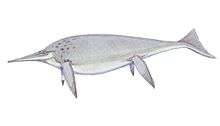
- Camp's ichthyosaur excavation in Nevada ceased.[33]
- Not far from Stowbridge in Norfolk, workers serendipitously discovered a large partial ichthyosaur skeleton while digging a drainage channel. The specimen was later thought to belong to the genus Ophthalmosaurus.[28]
1960s

- Camp resumed excavating the gigantic ichthyosaurs in Nevada.[33]
- Colbert hypothesized that ichthyosaurs were descended from cotylosaurs.[31]
- Camp's ichthyosaur excavation in Nevada ended, with 35–40 partial ichthyosaur skeletons unearthed.[33]
- Pollard reported that Temnodontosaurus ate cephalopods.[34]
1970s
- McGowan argued that the narrow-finned longipinnate and the broad-finned latipinnate ichthyosaurs could be distinguished based on features of their skulls.[35]
- McGowan described the cranial anatomy of Ichthyosaurus. He observed that it had a very large brain for a reptile. He interpreted the animal's large cerebellum as suggestive of highly coordinated bodily movements. He also noted that its large corpus striatum implied that it had a sophisticated repertoire of instinctive behaviors.[15] He speculated that social and parental behavior may have been among them.[36] By contrast, the lagena of Ichthyosaurus was small, suggesting that ichthyosaurs had weak sense of hearing.[37]

- Charles Camp died before he could finish his monograph on the Berlin-Ichthyosaur State Park ichthyosaurs.[38]
- Joseph Gregory, a friend of Charles Camp, published some of Camp's research on the ichthyosaurs of Berlin-Ichthyosaur State Park.[38]
- McGowan observed that the eyes of the supposed Ophthalmosaurus discovered in Norfolk during 1950s were too small for the animal to be referred to that genus and reclassified it in a new one: Grendelius.[28]
- McGowan observed that more ichthyosaur remains have been found in the Early Jurassic strata of southern Germany than anywhere else in the world.[18] He also speculated that in life most ichthyosaurs' biogeographic ranges would be as wide as those of modern whales and dolphins. McGowan attributed the narrow ranges of most known ichthyosaur species to an artifact of the fossil record, since paleontologists can only recover fossils from accessible exposures of sedimentary rocks formed in settings conducive to fossilization, which may not correspond to the complete life range of a given species.[39] He also rejected his own previous conclusion that latipinnate and longipinnate ichthyosaurs could be distinguished based on features of the skull and expressed doubt about the validity of the latipinnate-longipinnate dichotomy altogether.[35]
1980s
- Joseph Gregory published the rest of his late friend Charles Camp's research on the ichthyosaurs of Berlin-Ichthyosaur State Park. This publication contained a reconstruction of Shonisaurus portraying as a long-skulled long-finned animal with an unusually deep "pot belly".[38]
- Angela Kirton reported the presence of teeth in skulls attributable to Ophthalmosaurus from England. The toothlessness of many adult skulls suggest that either Ophthalmosaurus lost its teeth as it aged or the teeth were only loosely attached and prone to falling out after death.[27]
- Wade observed that the longest digit in the flipper of Platypterygius was made up of a series of 30 bones.[35]
- Fossils of an unusual ichthyosaur whose upper jaw was much longer than its lower jaw were found.[40]
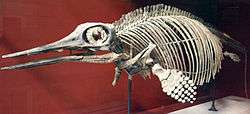
- An adult Ichthyosaurus communis specimen was found with a tiny associated embryo of the same species in Kilve, Somerset.[41]
- A man named Bernd Neubig discovered an ichthyosaur skeleton during construction of a railroad in Karlstadt, Germany. The specimen was the most complete ichthyosaur discovered in that region of the country.[38]
- Gasparini reported the first scientifically documented ichthyosaur remains from Argentina. He referred the Argentine ichthyosaur to the genus Ophthalmosaurus.[42]
- Christopher McGowan began leading a series of expeditions to Williston Lake, British Columbia, culminating in the discovery of the most complete known skeleton of Shastasaurus, which also served as the type specimen of a new species that would later be described in 1994.[43]

- German paleontologist Jurgen Reiss speculated that ichthyosaurs swam using their front flippers the way modern penguins do rather than propelling themselves with their tail fluked.[44]
- McGowan named the ichthyosaur with an unusually long, protruding upper jaw from Somerset Excalibosaurus, because it was found in the same general region where the legendary King Arthur obtained his sword.[40]
- Massare and Callaway described a pregnant Mixosaurus specimen discovered in the Alps near the border between Switzerland and Italy. The specimen represented the oldest known evidence for live birth in ichthyosaurs.[45]
- Three specimens attributable to a new Triassic ichthyosaur were discovered near Phattalung, Thailand by a man named Chongpan Chonglakmani.[46]
- In Dorset, England, a new specimen of Grendelius was discovered. However, when Christoper McGowan studied this new specimen he realized that while distinct from Ophthalmosaurus, Grendelius was apparently the same as the previously named genus Brachypterygius and the names were synonymized.[28]
- McGowan observed that many Leptonectes specimens have somewhat protruding upper jaws.[47]
- Remains of a Triassic ichthyosaur were discovered in Sonora, Mexico.[48]
- Callaway and Massare regarded the genus Phalarodon as a nomen dubium.[30]
1990s
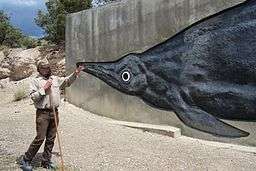
- Bradley Kosch of Berlin-Ichthyosaur State Park criticized Camp's 1980 reconstruction of the park's famous Shonisaurus popularis as having too short a backbone and overly deep ribs, responsible for its supposedly deep pot belly. He noted that the illustration differed from both the text of Camp's published description and his own private field notes.[38]
- Stephen Jay Gould published an article about the tail bend in ichthyosaurs.[5]
- De Buffrenil and Mazin found a woven texture in the bones of Ichthyosaurus, Omphalosaurus, and Stenopterygius. This texture is found only in the bones of quickly growing animals, suggesting that ichthyosaurs had high metabolic rates and may even have been warm blooded.[49]
- Massare and Callaway observed that Triassic ichthyosaurs had more elongated body plans than their Jurassic successors.[46]
- An archaeologist named Keary Walde discovered large fossil bones near the Sikanni Chief River. He reported his discovery to the Royal Tyrell Museum.[29] The museum's curator, Elizabeth Nicholls, was also a respected marine reptile researcher, visited the site.She was astonished to realize that the bones discovered by Walde were the remains of an ichthyosaur roughly 75 feet long, one and a half times as big as the largest known ichthyosaur at the time.[50]
 Skeletal reconstruction of a Stenopterygius with young partially evacuated from the birth canal. These specimens may not reflect the preservation of mothers in the act of giving birth, but deceased feti being expelled from her by pressure resulting from gas build up in her bloating carcass.
Skeletal reconstruction of a Stenopterygius with young partially evacuated from the birth canal. These specimens may not reflect the preservation of mothers in the act of giving birth, but deceased feti being expelled from her by pressure resulting from gas build up in her bloating carcass. - McGowan argued that ichthyosaur fossils with new-born remains protruding from the birth canal don't imply that the mother died giving birth. Instead, they could be expelled from an already dead mother by the pressure of gas-build up as her rotting carcass bloated. An example of this in modern marine life was documented where the carcasses of beached false killer whales were given a shallow burial. Several months later, the pregnant females' fetuses had been partly expelled.[18] He also observed that roughly 35 ichthyosaur specimens a year were still being recovered from Holzmaden.[51] He suggested that at least some ichthyosaurs may have been warm-blooded and swift swimming like modern tuna due to their similar body plans.[49] He also noted that even if they weren't warm blooded their large body mass would help maintain stable body temperatures.[52]
- Lingham-Soliar referred to the swimming style of advanced ichthyosaurs whose body remained stiff while large muscles powered the tail's swimming stroke as "axial oscillation".[53]
- Field work on behalf of Alberta's Royal Tyrell Museum began in the Pink Mountains of British Columbia 60 miles north of where Christopher McGowan's field work was conducted. The Royal Tyrell researchers would discover Late Triassic ichthyosaur remains in the sediments of the Pardonet Formation.[29]
- Judy Massare proposed an explanation for the high percentage of pregnant Stenopterygius at Holzmaden. She speculated that the area was used as a breeding ground, the way whales congregate to give birth in areas of shallow water today. The coordination of a large number of births at the same time and place would increase the young's chances of survival because there would be too many for the local predator population to eat. Massare suggested that another ichthyosaur genus, Leptopterygius (now known as Leptonectes), was one such local predator that may have fed on vulnerable young ichthyosaurs.[51]
- Nathalie Bardet dismissed claims of ichthyosaur fossils from rocks of more recent age than the Cenomanian. She also discussed possible causes for the extinction of the ichthyosaurs. She expressed doubt that ichthyosaurs were replaced by mosasaurs because they would not be in direct competition with each other. Instead she posited a connection to an extinction event that affected cephalopods at the boundary between the Cenomanian and Turonian ages. She proposed that the disappearance of these many cephalopod species may have deprived ichthyosaurs of their food source and caused their extinction.[54]
- Charles Deeming and others published a paper on the 1985 ichthyosaur embryo discovered in Somerset. They observed that many pregnant ichthyosaur specimens contain fetuses oriented head-first toward the birth canal even though they were probably born tail-first as a precaution to prevent drowning. This suggests that there may have been complications during the pregnancy, like the fetus being too large to pass through the birth canal. If the decomposing fetus remained trapped in the mother, it would very likely kill her.[55]

- Jennifer Hogler re-examined the tails of the early large ichthyosaurs Cymbospondylus and Shonisaurus, finding the wedge-shaped vertebrae that form the tail-bend that composes the tail fluke. This find contradicted the widespread idea that these early ichthyosaurs had straight tails and therefore lacked well-developed flukes.[56]
- Axel Hungerbuhler bemoaned the taxonomic confusion caused by German geologist Friedrich Quenstedt's early research on the ichthyosaurs at Holzmaden. He attributed the bulk of this confusion to Quenstedt's unorthodox naming practices, which often exceeded the two-named binomials of standard biological nomenclature to consist of three or four names. Further, the fossils themselves were poorly organized and many of the type specimens he founded species on were unlabeled. Hungerbuhler named two new species of his own: Stenopterygius cuniceps and S. macrophasma.[57]
- Christopher McGowan named the new species of Shastasaurus discovered in British Columbia S. neoscapularis.[43] He also reviewed the species previously referred to the genus, finding many of them to be dubious, like S. altus, S. careyi, S. carinthiacus, and S. osmonti. However, two previously described species, the type, S. pacificus, and the referred species S. alexandrae were found to be valid. He criticized Merriam for oversplitting Shastasaurus because most of the resulting names were useless and mislead the paleontological community into thinking that the genus was better understood than it really was.[29]
- Fernandez described the new ichthyosaur genus Chacaisaurus from the Vaca Muerta Formation of Argentina.[42]
- Bardet and others reported Platypterygius fossils from late Cenomanian rocks in Bavaria. These were the remains latest known ichthyosaurs.[54]
- January: A man named Chris Moore discovered much of the front half of an ichthyosaur skeleton in the Belemnite Marls of Seatown, Dorset. The specimen was a juvenile of a new Leptopterygius species, named L. moorei after Moore.[58] In life, the specimen was probably about 8 feet long.[39]
- McGowan renamed the ichthyosaur genus Leptopterygius to Leptonectes.[51] He also synonymized Leptopterygius with Temnodontosaurus.[51]
- Martill claimed that despite an abundance of ichthyosaur specimens with preserved soft tissue, there was no evidence that ichthyosaur skin was covered in scales.[15]
- Motani and others argued that sharks are the best modern analogues for ichthyosaurs because of their similar body plans.[53]
- McGowan reported the serendipitous discovery of evidence for a new giant ichthyosaur species in a museum collection. He was studying the ichthyosaur fossils curated by the National Academy of Sciences in Philadelphia. One Early Jurassic bone catalogued as a part of a shoulder (the coracoid) he recognized as actually being a gigantic skull bone (the quadrate). The misidentification was probably due to the quadrate's exceptionally large size as the coracoid is generally one of the larger bones in the ichthyosaur body.[59] The implication of such a large quadrate being found was the existence a previously unknown ichthyosaur of similar or greater size to Shonisaurus itself. In life this animal may have been more than 50 feet long.[42]
- Motani, You, and McGowan observed that the primitive ichthyosaur Chensaurus had had a relatively large number of vertebrae. This suggests that it swam in an eel-like fashion. The researchers interpreted the course of ichthyosaur evolution as starting with an eel-like body plan, transitioning to a jack-like body plan, and reaching its culmination in a tuna-like body plan.[60]

- Ryosuke Motani completed his doctoral dissertation: "Phylogeny of the Ichthyosauria with Special Reference to Triassic Forms".
- Callaway argued that it was inaccurate to refer to ichthyosaurs as ichthyopterygians.[16]
- Callaway examined the mixosaurid fossils housed at the natural history museum in Zurich.[22] He regarded only two species of Mixosaurus to be valid; M. cornalianus and M. atavus. He regarded M. maotaiensis, M. natans, and M. nordeskioeldii as junior synonyms of those species. He also regarded several species in the genus Phalarodon as synonymous with the two valid Mixosaurus species.[61]
- Martin Sander of the Institute for Paleontology in Bonn named the ichthyosaur found in Karlstadt, Germany Shastasaurus neubigi in honor of its discoverer. The specimen originated in the Muschelkalk, which was deposited in a shallow sea. Because the waters were so shallow and large ichthyosaurs are so infrequently found in the Muschelkalk Sander speculated that the ichthyosaur entered the region where it would later fossilize by accident in a deviation from the normal range of the species.[38]
- Motani, Minoura, and Ando published a discussion of the ichthyosaur Utatsusaurus. They noted its primitive position in the ichthyosaur family tree and the same number of vertebrae in the front part of its body as modern catsharks. They interpreted Utatsusaurus as a maneuverable shallow water predator that swam with eel-like undulations along most of its body length.[62]
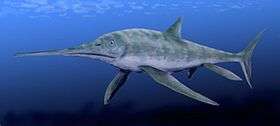
- Maisch named the family Leptonectidae for a clade including Eurhinosaurus, Excalibosaurus, and Leptonectes. Distinguishing traits of the family include their large eyes, long flippers consisting of three or four main "digits", and their long over-biting snouts.[39]
- Maisch and Matzke erected the genus Wimanius. The generic name honored Carl Wiman, who performed notable research on Triassic ichthyosaurs.[30]
- Maisch and Matzke described the new genus Contectopalatus. It had a high crest running the midlength of its cranium for jaw muscle attachment giving it a powerful bite. It also would have been about 16 feet long in life, making it twice as long as any previously discovered mixosaurid.[25]
- Maisch erected the genus Suevoleviathan to house the species Leptopterygius disinteger.[30]
- Darren Naisch debunked the 1986 claim by Jurgen Riess that ichthyosaurs swam with their front flippers rather than their tail flukes. He concluded "if an animal has a propulsive surface on the end of its tail, it uses it."[63]
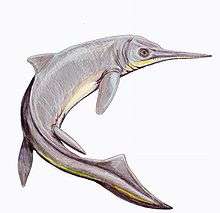
- Ryosuke Motani published a phylogeny of the ichthyosaurs. Motani regarded Thaisaurus as "incertae sedis" due to its pronounced similarity to Chaohusaurus and how little was known about its fossils.[46] He also erected two new genera, Macgowania (named in honor of McGowan) and Isfjordosaurus (named after Isfjord, Spitsbergen).[20]
- The expedition to the Sikanni Chief River, British Columbia led by Elizabeth Nicholls of the Royal Tyrell Museum excavated the animal's 18 foot long skull, which had to be split into pieces for removal. These pieces were so heavy a cargo helicopter was needed to transport them. The largest weighed 8,860 lbs.[7]
- McGowan and Motani reported the results of their re-examination of the Shonisaurus specimens described by Camp from Berlin-Ichthyosaur state park. They concluded that of the three species Camp described from among the remains, only the type and most abundant species S. popularis was valid. The other two species he named, S. silberlingi and S. mulleri, were merely junior synonyms of S. popularis.[38]
- Motani, Rothschild, and Wahl found that Temnodontosaurus had eyes up to 10 inches in diameter, the largest known of any animal.[28]
- March 6th: An article about ichthyosaurs called "Dinodolphin" by Kate Douglas was published in New Scientist magazine.[64]
- September: Rothschild, Motani, and Wahl presented an abstract to a meeting of the Society for Vertebrate Paleontology.[65] There they reported evidence that some Ophthalmosaurus suffered from the bends.[66]
- Fernandez described the new ichthyosaur genus Mollesaurus from the Los Molles Formation of Argentina.[42]
- Chun Li described the new ichthyosaur genus Qianichthyosaurus from Guizhou Province, China.[24]
- Lingham-Soliar proposed a model for ichthyosaur extinction whereby the evolution of fishes capable of greater swimming speeds during the Cretaceous favored ambush predators like plesiosaurs and the newly evolved mosasaurs over the ichthyosaurs, who succumbed to the competition.[67]
21st century
2000s
- Ryosuke Motani published an article on ichthyosaurs in Scientific American that documented the discovery of Utatsusaurus.[68]
- Swiss watch maker Rolex honored Elizabeth Nicholls as a Rolex Laureate and bestowed on her a $100,000 stipend, covering much of the expenses generated by her field work.[7]
- Sander expressed doubt as to whether or not Omphalosaurus was really an ichthyosaur. He also cast doubt on the idea that the limb bones from Spitsbergen referred to the genus by Carl Wiman actually belonged to the same kind of animal as the jaws discovered by J. C. Merriam that served as its type specimen.[25]
- May: Nathalie Bardet and Marta Fernandez erected the new genus Aegirosaurus to house the species Ichthyosaurus leptospondylus. This was first new ichthyosaur to be described from the Solnhofen lithographic limestone in over 50 years prior to its naming.[24] The type specimen preserved extensive soft tissue traces. Bardet and Fernandez reported the presence of tiny scales covering the animal.[69] They disagreed with Martill, who claimed in 1995 that no evidence of a scaley covering existed in ichthyosaurs.[15]
- Maisch and Matzke erected the new genus Callawayia for the species Shastasaurus neoscapularis.[70]
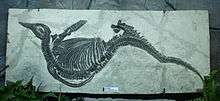
- Maisch and Matzke recognized the genus Phalarodon as diagnostic rather than dubious.[30] They referred the species "Mixsaurus" major of the German Muschelkalk to that genus, and noted that this represented the first report of Phalarodon in that locality.[71]
- Nicholls and Manabe erected the new genus Metashastasaurus for the species Shastasaurus neoscapularis.[72] However, since the genus Callawayia had already been named for this species by Maisch and Matzke it was never accepted as valid by the scientific community. Nicholls and Manabe also reported that since field work began in the Pardonet Formation of British Columbia's Pink Mountains, 65 ichthyosaur specimens had been recovered.[29]
- Orndorff and others interpreted the burial site of the famous ichthyosaurs of Berlin-Ichthyosaur State Park as a deep ocean shelf rather than a shallow coastal area. They also proposed a new reinterpretation of the animal's deaths, suggesting that the deposit may represent a school of Shonisaurus that was paralyzed by neurotoxins in the fish or shellfish that they ate before sinking to their death. They compared their hypothesis to modern mass whale deaths off the coast of New England. However, this interpretation is considered doubtful as there is no evidence linking mass whale deaths with consumption of poisonous sealife.[33]
- Dino Frey and others reported the presence of ichthyosaur vertebrae in the collection of the Faculty of Geoscience in Linares, Mexico. They expressed interest in returning to Mexico to study the remains further and search for new finds.[42]
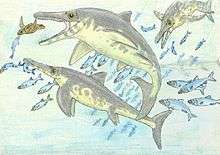
- Paleontologist Ben Kear collaborated with radiographer George Kourlis to perform a CT scan of Platypterigius. They found that its inner ear bones were so thick that they could not transmit sound vibrations and concluded animal must have been deaf. The scan also exposed the sensory structures inside its nose that allowed it to smell as well as an unusual system of "channels and grooves". The researchers found embryonic remains inside a Platypteriguis from Hughenden, Queensland, as well as the remains of the belemnites, fish, and turtle hatchlings it ate.[73]
- Li and You described the new species Cymbospondylus asiaticus. The known remains of this species consisted of two skulls excavated from the Late Triassic Falang Formation of Guizhou Province, China. This was the first known example of the genus in Asia.[74]
- Perkins speculated that the channels and grooves uncovered by Kear and Kourlis in the skull of Platypterigius via CT scan formed a electrosensory system similar to those possessed by modern sharks.[73]
- Peter Doyle gave an interview to New Scientist magazine discussing acid-etched belemnite shells, that he believed originated as ichthyosaur vomit.[32]
- Ryosuke Motani compared the bodies and hydrodynamics of aquatic life with a "thunniform" body plan like dolphins, lamnid sharks, tunas, and the ichthyosaur Stenopterygius quadriscissus. He modeled the motions of a thunniform body and its interaction with the water finding that, contrary to the conclusions of previous research, the tail fin of a thunniform animal was evolved to enable cruising at large body sizes rather than for "propuslive efficiency". He hypothesized that the similar body plans shared between ichthyosaurs and tunas suggest similar high swimming speeds and metabolic rates.[49]

- Stuart Humphries and Graeme Ruxton published a study on the eyes of Ophthalmosaurus.[75] They calculated its eyes to be two and half to four times as light sensitive as the modern elephant seal. Since elephant seals can themselves dive thousands of feet deep, the researchers concluded that increased light sensitivity in deep water was probably not the only evolutionary pressure behind the evolution of large eyes in Ophthalmosaurus. Its large eyes would have given it exceptionally clear vision as well, which would have been useful for tracking small prey and in possible social behavior.[65]
- Thegarten Lingham-Soliar argued against Nathalie Bardet's attribution of ichtyosaur extinction to the loss of their preferred food sources in the Cenomanian-Turonian extinction event expanded on his own 1999 attribution of ichthyosaur extinction to biotic factors. During the Cretaceous the evolution of many fish groups trended towards faster swimming body types, making them harder to hunt for adult ichthyosaurs and harder to escape from for newborn ichthyosaurs. This ecological scene favored ambush predators like plesiosaurs and the newly evolved mosasaurs over the ichthyosaurs, who succumbed to the competition.[67]
- Elizabeth Nicholls, Chen Wei, and Makato Manabe published an extensive description of a new, complete specimen of Qianichthyosaurus from Guizhou. They observed that it was very similar to the genus Toretocnemus from California and concluded that similar ichthyosaur faunas spanned the Pacific Ocean during the Late Triassic.[24]
2010s
- Maxwell described the new genus Arthropterygius[76]
- Druckenmiller and Maxwell described the new genus and species Athabascasaurus bitumineus[77]
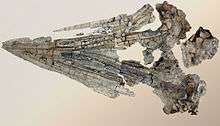
- Maisch described the new genus Barracudasauroides and new species Omphalosaurus merriami[78]
- Chen and Cheng described the new species Mixosaurus xindianensis[79]
- Fischer and others described the new genus and species Sveltonectes insolitus[80]
- Fischer and others described the new genus and species Acamptonectes densus[81]
- Druckenmiller and others described the new genera and species Cryopterygius kristiansenae and Palvennia hoybergeti[82]
- Maxwell, Fernández, and Schoch described the new species Stenopterygius aaleniensis[83]
- Martin and others described the new species Temnodontosaurus azerguensis[84]
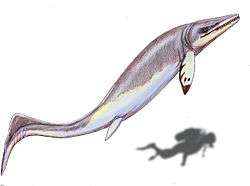
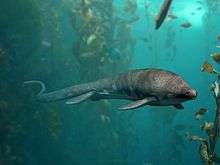
- Chen and others described the new species Chaohusaurus zhangjiawanensis[85]
- Cuthbertson, Russell and Anderson described the new genus and species Gulosaurus helmi[86]
- Fischer and others described the new genus and species Malawania anachronus[87]
- Fröbisch and others described the new genus and species Thalattoarchon saurophagis[88]
- Roberts and others described the new genus and species Janusaurus lundi[89]
- Fischer and others described the new genus Leninia stellans[90]
- Fischer and others described the new genus and species Sisteronia seeleyi[91]
- Arkhangelsky and Zverkov described the new species Undorosaurus trautscholdi[92]
- Motani and others described the new genus and species Cartorhynchus lenticarpus[77]
- Brusatte and others described the new genus and species Dearcmhara shawcrossi[93]
- Chen and others described the new genus and species Eretmorhipis carrolldongi[85]
- Lomax and Massare described the new species Ichthyosaurus anningae[94]
- Maxwell and others described the new genus and species Muiscasaurus catheti[95]
- Jiang and others described the new genus and species Sclerocormus parviceps.[96]
- Paparella and others described the new genus and species Gengasaurus.
- Lomax described the new genus and species Wahlisaurus.
- Lomax and Massare described the new species Ichthyosaurus larkini and I. somersetensis.
- Tyborowski described the new species Cryopterygius kielanae.
See also
Footnotes
- 1 2 Ellis (2003); "The Ichthyosaurs," page 65.
- 1 2 3 4 5 6 Ellis (2003); "The Ichthyosaurs," page 67.
- ↑ Emling (2009); in passim.
- 1 2 Ellis (2003); "The Ichthyosaurs," pages 70–71.
- 1 2 3 Ellis (2003); "The Ichthyosaurs," page 71.
- 1 2 Ellis (2003); "The Ichthyosaurs," pages 71–72.
- 1 2 3 4 5 Ellis (2003); "The Ichthyosaurs," page 90.
- ↑ Ellis (2003); "The Ichthyosaurs," pages 91–92.
- 1 2 3 Ellis (2003); "The Ichthyosaurs," page 107.
- ↑ Ellis (2003); "The Ichthyosaurs," pages 114–116.
- ↑ Ellis (2003); "The Ichthyosaurs," pages 67–68.
- ↑ Ellis (2003); "The Ichthyosaurs," page 68.
- ↑ Ellis (2003); "The Ichthyosaurs," page 70.
- ↑ Ellis (2003); "The Marine Reptiles: An Overview", page 21.
- 1 2 3 4 Ellis (2003); "The Ichthyosaurs," page 97.
- 1 2 Ellis (2003); "The Ichthyosaurs," pages 87–88.
- 1 2 Ellis (2003); "The Ichthyosaurs," page 113.
- 1 2 3 4 Ellis (2003); "The Ichthyosaurs," page 74.
- ↑ Ellis (2003); "The Ichthyosaurs," page 72.
- 1 2 Ellis (2003); "The Ichthyosaurs," page 84.
- ↑ Ellis (2003); "The Ichthyosaurs," pages 84–85.
- 1 2 Ellis (2003); "The Ichthyosaurs," page 85.
- ↑ Ellis (2003); "The Ichthyosaurs," page 88.
- 1 2 3 4 Ellis (2003); "The Ichthyosaurs," page 96.
- 1 2 3 4 Ellis (2003); "The Ichthyosaurs," page 87.
- ↑ McGowan (1994); "Taxonomic History of E. longirostris," page 748.
- 1 2 Ellis (2003); "The Ichthyosaurs," page 112.
- 1 2 3 4 5 Ellis (2003); "The Ichthyosaurs," page 109.
- 1 2 3 4 5 Ellis (2003); "The Ichthyosaurs," page 89.
- 1 2 3 4 5 Ellis (2003); "The Ichthyosaurs," page 86.
- 1 2 Ellis (2003); "The Ichthyosaurs," page 63.
- 1 2 Ellis (2003); "The Ichthyosaurs," page 100.
- 1 2 3 4 Ellis (2003); "The Ichthyosaurs," page 91.
- ↑ Ellis (2003); "The Ichthyosaurs," pages 105–106.
- 1 2 3 Ellis (2003); "The Ichthyosaurs," page 105.
- ↑ Ellis (2003); "The Ichthyosaurs," pages 97–98.
- ↑ Ellis (2003); "The Ichthyosaurs," pages 98–99.
- 1 2 3 4 5 6 7 Ellis (2003); "The Ichthyosaurs," page 92.
- 1 2 3 Ellis (2003); "The Ichthyosaurs," page 82.
- 1 2 Ellis (2003); "The Ichthyosaurs," page 106.
- ↑ Ellis (2003); "The Ichthyosaurs," pages 72–73.
- 1 2 3 4 5 Ellis (2003); "The Ichthyosaurs," page 95.
- 1 2 Ellis (2003); "The Ichthyosaurs," pages 88–89.
- ↑ Ellis (2003); "The Ichthyosaurs," page 102.
- ↑ Ellis (2003); "The Ichthyosaurs," page 76.
- 1 2 3 Ellis (2003); "The Ichthyosaurs," page 80.
- ↑ Ellis (2003); "The Ichthyosaurs," pages 106–107.
- ↑ Mayor (2005); "The Baboquivari Monster of Tohono O'odham Lore," page 344.
- 1 2 3 Ellis (2003); "The Ichthyosaurs," page 103.
- ↑ Ellis (2003); "The Ichthyosaurs," pages 89–90.
- 1 2 3 4 Ellis (2003); "The Ichthyosaurs," page 81.
- ↑ Ellis (2003); "The Ichthyosaurs," pages 103–104.
- 1 2 Ellis (2003); "The Ichthyosaurs," page 79.
- 1 2 Ellis (2003); "The Ichthyosaurs," page 114.
- ↑ Ellis (2003); "The Ichthyosaurs," pages 73–74.
- ↑ Ellis (2003); "The Ichthyosaurs," page 93.
- ↑ Ellis (2003); "The Ichthyosaurs," page 75.
- ↑ Ellis (2003); "The Ichthyosaurs," pages 81–82.
- ↑ Ellis (2003); "The Ichthyosaurs," page 94.
- ↑ Ellis (2003); "The Ichthyosaurs," page 104.
- ↑ Ellis (2003); "The Ichthyosaurs," pages 85–86.
- ↑ Ellis (2003); "The Ichthyosaurs," pages 78–79.
- ↑ Ellis (2003); "The Ichthyosaurs," pages 102–103.
- ↑ Ellis (2003); "The Ichthyosaurs," pages 64–65.
- 1 2 Ellis (2003); "The Ichthyosaurs," page 111.
- ↑ Ellis (2003); "The Ichthyosaurs," pages 111–112.
- 1 2 Ellis (2003); "The Ichthyosaurs," page 115.
- ↑ Ellis (2003); "The Ichthyosaurs," pages 80–81.
- ↑ Ellis (2003); "The Ichthyosaurs," pages 96–97.
- ↑ Maisch and Matzke (2000); "Abstract," page 1.
- ↑ Ellis (2003); "The Ichthyosaurs," pages 86–87.
- ↑ Nicholls and Manabe (2001); "Abstract," page 983.
- 1 2 Ellis (2003); "The Ichthyosaurs," page 99.
- ↑ Ellis (2003); "The Ichthyosaurs," pages 93–94.
- ↑ Ellis (2003); "The Ichthyosaurs," pages 110–111.
- ↑ Maxwell (2010); in passim.
- 1 2 Druckenmiller and Maxwell (2010); in passim.
- ↑ Maisch (2010); in passim.
- ↑ Chen and Cheng (2010); in passim.
- ↑ Fischer et al. (2011) "A New Barremian..."; in passim.
- ↑ Fischer et al. (2012); in passim.
- ↑ Druckenmiller et al. (2012); in passim.
- ↑ Maxwell, Fernández and Schoch (2012); in passim.
- ↑ Martin et al. (2012); in passim.
- 1 2 Chen et al. (2013); in passim.
- ↑ Cuthbertson, Russell, and Anderson (2013); in passim.
- ↑ Fischer et al. (2013); in passim.
- ↑ Fröbisch et al. (2013); in passim.
- ↑ Roberts et al. (2014); in passim.
- ↑ Fischer et al. (2014) "A New Lower Cretaceous..."; in passim.
- ↑ Fischer et al. (2014) "High Diversity..."; in passim.
- ↑ Arkhangelsky and Zverkov (2014); in passim.
- ↑ Brusatte et al. (2015); in passim.
- ↑ Lomax and Massare et al. (2015); in passim.
- ↑ Maxwell et al. (2015); in passim.
- ↑ Jiang et al. (2016); in passim.
References
- M.S. Arkhangelsky and N.G. Zverkov (2014). "On a new ichthyosaur of the genus Undorosaurus" (PDF). Proceedings of the Zoological Institute of the Russian Academy of Sciences. 318 (3): 187–196.
- Stephen L. Brusatte, Mark T. Young, Thomas J. Challands, Neil D. L. Clark, Valentin Fischer, Nicholas C. Fraser, Jeff J. Liston, Colin C. J. MacFadyen, Dugald A. Ross, Stig Walsh and Mark Wilkinson (2015). "Ichthyosaurs from the Jurassic of Skye, Scotland". Scottish Journal of Geology. 51 (1): 43–55. doi:10.1144/sjg2014-018.
- Chen Xiao-hong & Cheng Long (2010). "A new species of Mixosaurus (Reptilia: Ichthyosauria) from the Middle Triassic of Pu'an, Guizhou, China". Acta Palaeontologica Sinica (2): 251–260.
- Xiaohong Chen, P. Martin Sander, Long Cheng and Xiaofeng Wang (2013). "A New Triassic Primitive Ichthyosaur from Yuanan, South China". Acta Geologica Sinica (English Edition). 87 (3): 672–677. doi:10.1111/1755-6724.12078.
- Xiao-hong Chen, Ryosuke Motani, Long Cheng, Da-yong Jiang and Olivier Rieppel (2015). "A New Specimen of Carroll's Mystery Hupehsuchian from the Lower Triassic of China". PLoS ONE. 10 (5): e0126024. doi:10.1371/journal.pone.0126024.
- Robin S. Cuthbertson, Anthony P. Russell and Jason S. Anderson (2013). "Cranial morphology and relationships of a new grippidian (Ichthyopterygia) from the Vega-Phroso Siltstone Member (Lower Triassic) of British Columbia, Canada". Journal of Vertebrate Paleontology. 33 (4): 831–847. doi:10.1080/02724634.2013.755989.
- Patrick S. Druckenmiller & Erin E. Maxwell (2010). "A new Lower Cretaceous (lower Albian) ichthyosaur genus from the Clearwater Formation, Alberta, Canada". Canadian Journal of Earth Sciences. 47 (8): 1037–1053. Bibcode:2010CaJES..47.1037D. doi:10.1139/E10-028. Retrieved 14 January 2011.
- Patrick S. Druckenmiller, Jørn H. Hurum, Espen M. Knutsen and Hans Arne Nakrem (2012). "Two new ophthalmosaurids (Reptilia: Ichthyosauria) from the Agardhfjellet Formation (Upper Jurassic: Volgian/Tithonian), Svalbard, Norway" (PDF). Norwegian Journal of Geology. 92 (2–3): 311–339.
- Ellis, Richard, (2003) Sea Dragons – Predators of the Prehistoric Oceans. University Press of Kansas. ISBN 0-7006-1269-6.
- Emling, Shelley (2009), The Fossil Hunter: Dinosaurs, Evolution, and the Woman whose Discoveries Changed the World, Palgrove Macmillan, ISBN 978-0-230-61156-6
- Fischer, V.; Masure, E.; Arkhangelsky, M.S.; and Godefroit, P. (2011). "A new Barremian (Early Cretaceous) ichthyosaur from western Russia". Journal of Vertebrate Paleontology. 31 (5): 1010–1025. doi:10.1080/02724634.2011.595464.
- Fischer,V.; Maisch, M.W.; Naish, D.; Kosma, R.; Liston, J.; Joger, U.; Krüger, F.J.; Pérez,J.P.; Tainsh, J.; Appleby, R.M. (2012). "New Ophthalmosaurid Ichthyosaurs from the European Lower Cretaceous Demonstrate Extensive Ichthyosaur Survival across the Jurassic–Cretaceous Boundary". PLoS ONE. 7 (1): e29234. doi:10.1371/journal.pone.0029234. PMC 3250416
 . PMID 22235274.
. PMID 22235274. - Valentin Fischer, Robert M. Appleby, Darren Naish, Jeff Liston, James B. Riding, Stephen Brindley and Pascal Godefroit (2013). "A basal thunnosaurian from Iraq reveals disparate phylogenetic origins for Cretaceous ichthyosaurs". Biology Letters. 9 (4): 20130021. doi:10.1098/rsbl.2013.0021.
- Valentin Fischer, Maxim S. Arkhangelsky, Gleb N. Uspensky, Ilya M. Stenshin and Pascal Godefroit (2014). "A new Lower Cretaceous ichthyosaur from Russia reveals skull shape conservatism within Ophthalmosaurinae". Geological Magazine. 151 (1): 60–70. doi:10.1017/S0016756812000994.
- Valentin Fischer, Nathalie Bardet, Myette Guiomar and Pascal Godefroit (2014). "High Diversity in Cretaceous Ichthyosaurs from Europe Prior to Their Extinction". PLoS ONE. 9 (1): e84709. doi:10.1371/journal.pone.0084709.
- Michael W. Maisch (2010). "Phylogeny, systematics, and origin of the Ichthyosauria – the state of the art" (PDF). Palaeodiversity. 3: 151–214. Retrieved 14 January 2011.
- Jeremy E. Martin, Valentin Fischer, Peggy Vincent and Guillaume Suan (2012). "A longirostrine Temnodontosaurus (Ichthyosauria) with comments on Early Jurassic ichthyosaur niche partitioning and disparity". Palaeontology. 55 (5): 995–1005. doi:10.1111/j.1475-4983.2012.01159.x.
- Nadia B. Fröbisch, Jörg Fröbisch, P. Martin Sander, Lars Schmitz and Olivier Rieppel (2013). "Macropredatory ichthyosaur from the Middle Triassic and the origin of modern trophic networks". Proceedings of the National Academy of Sciences of the United States of America. 110 (4): 1393–1397. doi:10.1073/pnas.1216750110.
- Da-Yong Jiang, Ryosuke Motani, Jian-Dong Huang, Andrea Tintori, Yuan-Chao Hu, Olivier Rieppel, Nicholas C. Fraser, Cheng Ji, Neil P. Kelley, Wan-Lu Fu and Rong Zhang (2016). "A large aberrant stem ichthyosauriform indicating early rise and demise of ichthyosauromorphs in the wake of the end-Permian extinction". Scientific Reports. 6: Article number 26232. doi:10.1038/srep26232.
- Dean R. Lomax & Judy A. Massare (2015). "A new species of Ichthyosaurus from the Lower Jurassic of West Dorset, England, U.K.". Journal of Vertebrate Paleontology. 35 (2): e903260. doi:10.1080/02724634.2014.903260.
- M. W. Maisch and A. T. Matzke. 2000. The Ichthyosauria. Stuttgarter Beitrage zur Naturkunde, Serie B (Geologie und Palaontologie) 298:1–159.
- Maxwell, E. E (2010). "Generic reassignment of an ichthyosaur from the Queen Elizabeth Islands, Northwest Territories, Canada". Journal of Vertebrate Paleontology. 30 (2): 403–415. doi:10.1080/02724631003617944.
- Erin E. Maxwell, Marta S. Fernández and Rainer R. Schoch (2012). "First Diagnostic Marine Reptile Remains from the Aalenian (Middle Jurassic): A New Ichthyosaur from Southwestern Germany". PLoS ONE. 7 (8): e41692. doi:10.1371/journal.pone.0041692.
- Erin E. Maxwell, Daniel Dick, Santiago Padilla and Mary Luz Parra (2015). "A new ophthalmosaurid ichthyosaur from the Early Cretaceous of Colombia". Papers in Palaeontology. Online edition. doi:10.1002/spp2.1030.
- Mayor, Adrienne. Fossil Legends of the First Americans. Princeton University Press. 2005. ISBN 0-691-11345-9.
- McGowan. 1994. The taxonomic status of the Upper Liassic ichthyosaur Eurhinosaurus longirostris. Palaeontology 37(4):747–753.
- Aubrey Jane Roberts, Patrick Scott Druckenmiller, Glenn-Peter Sætre and Jørn Harald Hurum (2014). "A New Upper Jurassic Ophthalmosaurid Ichthyosaur from the Slottsmøya Member, Agardhfjellet Formation of Central Spitsbergen". PLoS ONE. 9 (8): e103152. doi:10.1371/journal.pone.0103152.
- Ryosuke Motani, Da-Yong Jiang, Guan-Bao Chen, Andrea Tintori, Olivier Rieppel, Cheng Ji and Jian-Dong Huang (2015). "A basal ichthyosauriform with a short snout from the Lower Triassic of China". Nature. 517 (7535): 485–488. doi:10.1038/nature13866.
- E. L. Nicholls and M. Manabe. 2001. A new genus of ichthyosaur from the Late Triassic Pardonet Formation of British Columbia: bridging the Triassic-Jurassic gap. Canadian Journal of Earth Sciences 38:983–1002.
External links
-
 Media related to Ichthyosauromorpha at Wikimedia Commons
Media related to Ichthyosauromorpha at Wikimedia Commons -
 Works related to Category:Ichthyosaurs at Wikisource
Works related to Category:Ichthyosaurs at Wikisource
